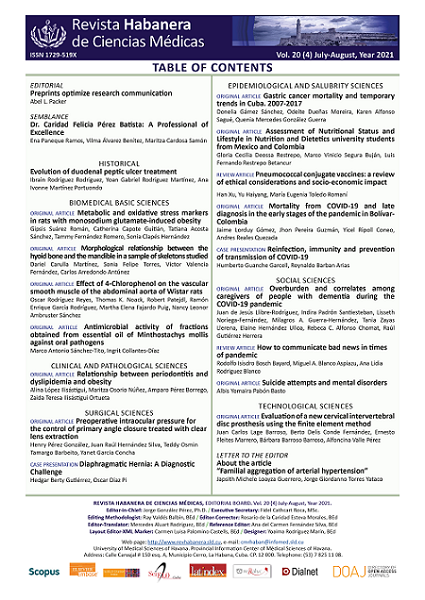Evaluation of a new cervical intervertebral disc prosthesis using the finite element method
Keywords:
Cervical disc herniation, arthroplasty, intervertebral disc prosthesis, finite element method.Abstract
Introduction: The initial treatment of cervicalgia due to degeneration of the intervertebral discs is conservative, but in case of failure, discectomy is the usual surgical option, replacing the disc with a bone graft or another structure that fully or partially fulfills the functions of the former. The Neurosurgery Service of the Camilo Cienfuegos General Hospital in Cuba has designed a new cervical intervertebral disc prosthesis model to treat this disease.
Objective: To evaluate the mechanical performance of the prosthesis designed through the finite element method under the usual loads of the cervical spine. Material and Methods: An experimental study was carried out using numerical simulation according to the finite element method, subjecting the prosthesis to the axial loads recommended by ASTM F2423-11e ISO 18192-1.2011 standards using Free CAD 0.18 software.
Results: The greatest efforts supported by the prosthesis in the neutral position, anterior flexion and lateral flexion were 28.79 MPa, 52.29 MPa and 55.59 MPa, respectively. The prosthesis did not suffer any fracture as it did not exceed the values prior to the elastic limit of the material that constitutes it. The greatest deformation described was 1 μm.
Conclusions: The highest concentration of efforts in the prosthesis was located at the point of contact of the prismatic cavity of the upper part when making contact with the prism of the lower part. The designed device did not undergo any significant deformation or fracture at the applied loads.
Downloads
References
1. Abdou S. Inter-vertebral disc prosthesis with variable rotational stop and methods of use. Estados Unidos; US 8303660 B1. November 2012.
2. Vialle LR, Manubu I, Riew KD. AOSpine Masters Series. Cervical Degenerative Condition. New York: Thieme; 2015.
3. María PP. Cervical Spine. Minimally Invasive and Open Surgery. New York: Springer; 2016.
4. Lafuente J. El implante discal cervical como alternativa a la artrodesis en el tratamiento quirúrgico de la cervicoartrosis [Tesis Doctoral]. Barcelona: Universidad Autónoma de Barcelona; 2000.
5. Lage JC, Conde BD, Fleites E. Tratamiento de la hernia discal cervical. Hospital General Provincial “Camilo Cienfuegos”. Gaceta Médica Espirituana [Internet]. 2020 [Citado 02/08/2020];22(2):[Aprox. 2p.]. Disponible en: http://www.revgmespirituana.sld.cu/index.php/gme/issue/view/117
6. Chin KR, Pencle F, Benny A, Seale JA. Placing ball and socket cervical total disc replacement using instant center of rotation. Journal of Orthipaedics. 2019; 16: 390-2.
7. Hammer C, Heller J, Kepler C. Epidemiology and pathophysiology of cervical disc herniation. Seminars in Spine Surgery. 2016; 28: 64-7.
8. Ting kui W. Cervical disc arthroplasty for the treatment of adjacent segment disease: A systematic review of clinical evidence. Clinical Neurology and Neurosurgery. 2017; 162: 1-11.
9. Tingkui W. Artificial cervical disc replacement with the Prestige-LP prosthesis forthe treatment of non-contiguous 2-level cervical degenerative discdisease: A minimum 24-month follow-up. Clinical Neurology and Neurosurgery. 2017; 152: 57-62.
10. Nesterenko SO, Riley LH, Skolasky, RL. Anterior cervical discectomy and fusion versus cervical disc arthroplasty: current state and trends in treatment for cervical disc pathology. Spine. 2012; 37: 1470-74.
11. Coombs DJ, Rullkoetter PJ, Laz PJ. Efficient probabilistic finite element analysis of a lumbar motion segment. Journal of Biomechanics. 2017; 61: 65-74.
12. Muñoz J. Modelo numérico de una unidad vertebral funcional humana. [Tesis de grado]. Madrid: Universidad Carlos III Madrid; 2015.
13. Celigüeta JT. Método de los elementos finitos para análisis estructural. 3 ed. San Sebastián: UNICOPIA C.B; 2008.
14. Schwer LE. Guide for Verification and Validation in Computational Solid Mechanics. United States of America: The American Society of Mechanical Engineers; 2006.
15. Fragkou K. Mechanical and Computational Modeling of Implants. [Tesis de Mestría]. Grecia:Universidad de Patras; 2017.
16. ASTM F2423-11 Standard Guide for Functional, Kinematic, and Wear Assessment of Total Disc Prostheses. En: Annual Book of ASTM Standards. USA: ASTM International; 2011. p. 1-9.
17. International Organization for Standardization. ISO 18192-1.2011 Implants for Surgery-Wear of Total Intervertebral Spinal Disc Prostheses-Part 1: Loading and Displacement Parameters for Wear Testing and Corresponding Environmental Conditions for Tests. Geneva: International Organization for Standardization; 2011.
18. Protechno. Advanced products for dental labs [Internet]. España: Protechno; 2017 [Citado 02/08/2020].
Disponible en: www.protechno.com
19. O´Brrien WJ, Ryge G. Materiales dentales y su selección. La Habana: ECIMED; 2005.
20. Blancas I, Aguilar S. Diseño de prótesis de disco intervertebral lumbar [Tesis de grado]. Mexico: Universidad Nacional Autónoma de México; 2014.
21. Doicin CV, Ulmeanu ME, Frincu AS, Echache VC. Concept Development of a New Lumbar Intervertebral Disk Implant. MATEC Web of Conf. 2017; 137: 1-12.
22. Li Y. Finite element analysis of influence of axial position of center of rotation of a cervical total disc replacement on biomechanical parameters: simulated 2-level replacement based on a validated model. World
Neurosuegery. 2017; 106: 932-8.
23. Chen WM. Strain behavior of malaligned cervical spine implanted with metal-onpolyethylene, metal-on-metal, and elastomeric artificial disc prostheses - A finite element analysis. Clinical Biomechanics. 2018; 59:1 9-26.
24. Goel V, Faizan A, Palepu V, Bhattacharya S. Parameters that effect spine biomechanics following cervical disc replacement. European Spine Journal. 2012; 21 (5): 688-99.
25.Yu CC. A new cervical artificial disc prosthesis based on physiological curvature of end plate: a finite element analysis. The Spine Journal. 2016; 16: 1384-91.
26. Jun Z. Biomechanical effects of cervical arthroplasty with U-shaped disc implant on segmental range of motion and loading of surrounding soft tissue. European Spine Journal. 2014; 23: 613-21.
27. Ho J, Man W, Hyuk Y, Jahng TA. A Biomchanical Analysis of an Artificial Disc Whith a Shock-absorbing FinCore Property by Using Whole-cervical Spine Finite Element Analysis. SPINE. 2016; 41 (15): E893-E901.



